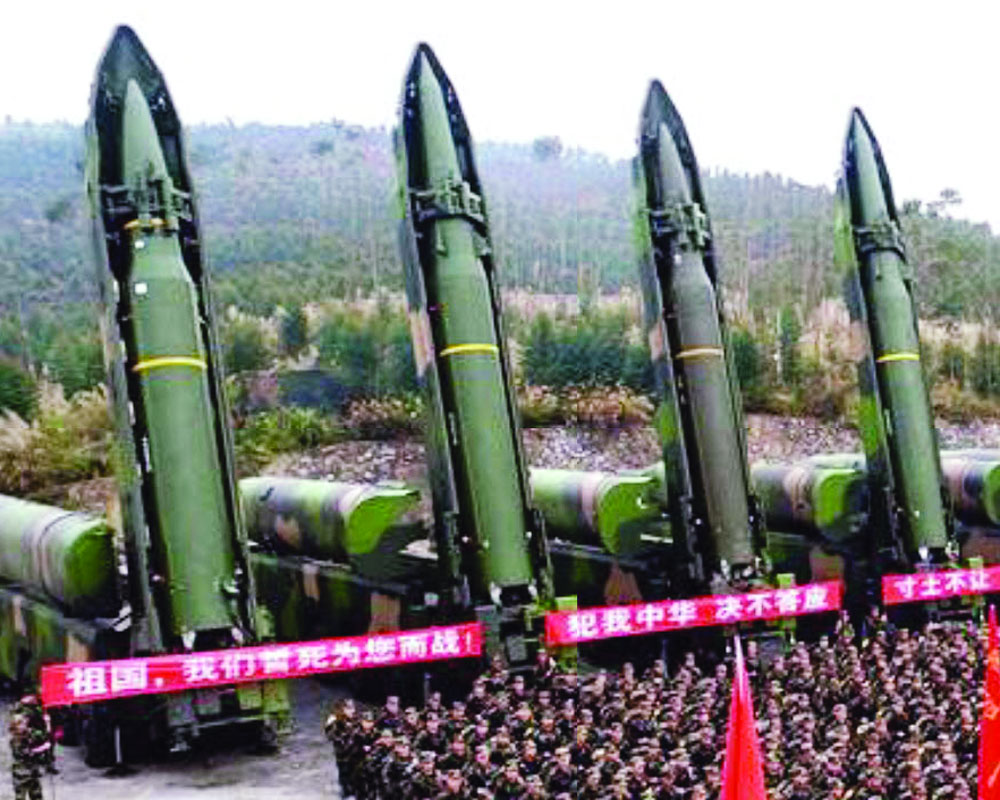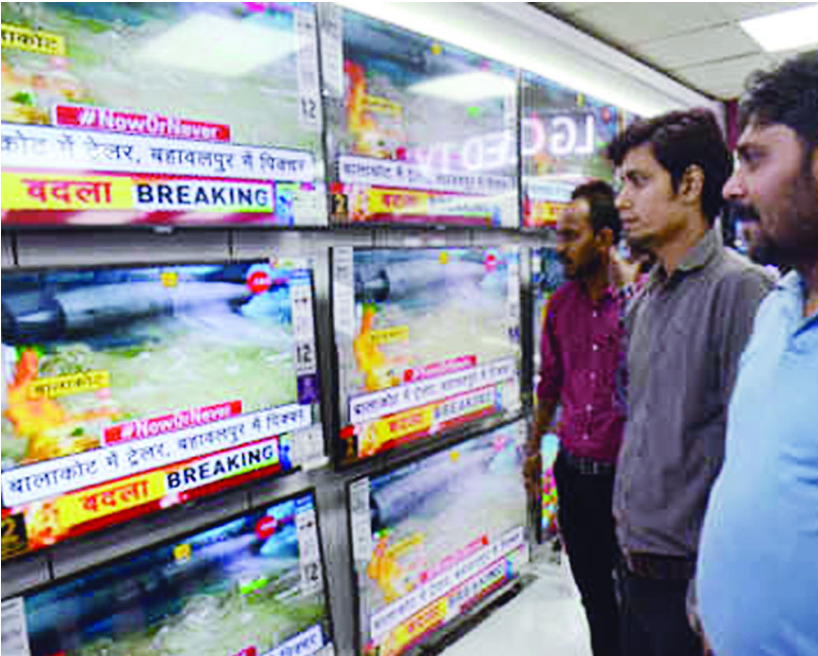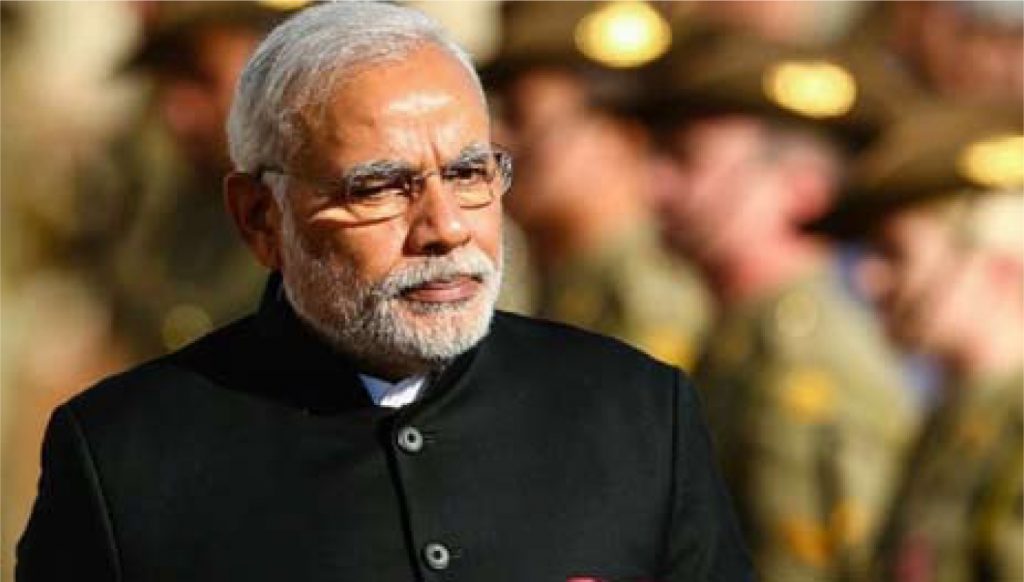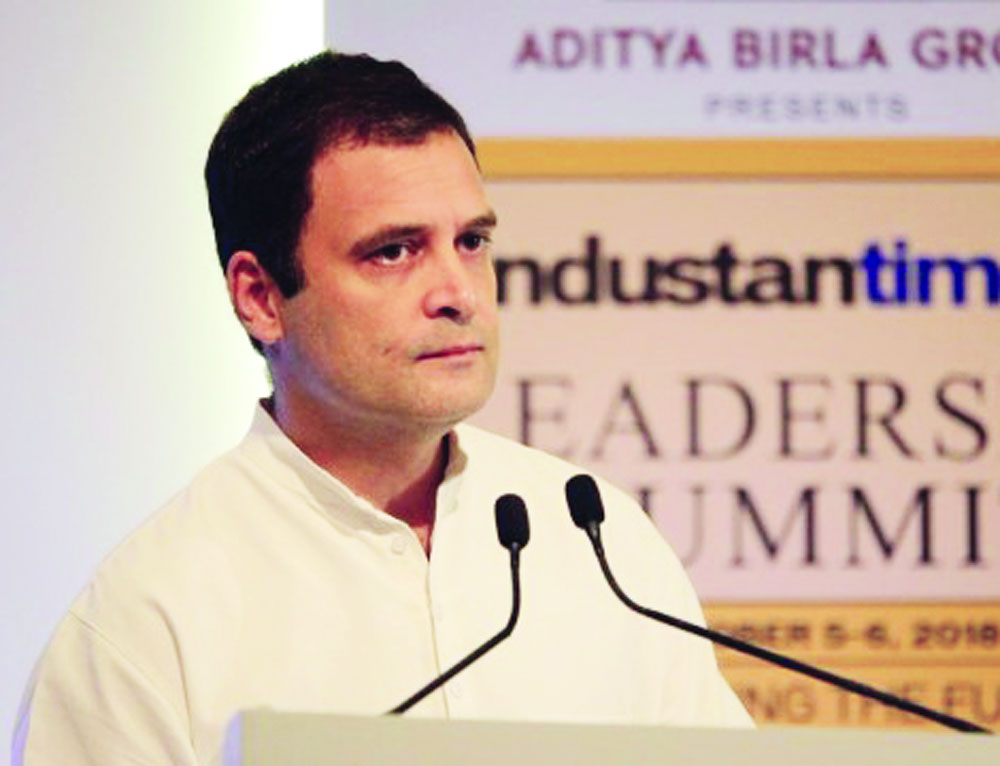
India needs to increase focus on research
by Hima Bindu Kota / 17 April 2019If India’s demographic dividend is to be tapped into, the country must be innovative in its approach and work out policies to boost research. The way forward should be advancing research
Research is the cornerstone of great institutions. Without it, a professor should not be eligible to teach at the university level as he/she will not be in a position to teach anything new to the students other than what is available in textbooks. The only benchmark to judge the quality of a university is its research standard. And Indian universities and prized management institutes do not fare well going by this count. Quality in research is deteriorating and so are the great institutions that were built so painstakingly by our great researchers.
According to the World Bank, India’s higher education system is the third largest in the world, next to the US and China, but it fares miserably in terms of expenditure per student as well as per teacher. In the last decade, access to higher education has improved as more IITs, IIMs and Central and State-level universities have been established. However, this proliferation has also raised concerns about an imbalance between excellence and inclusion. Regional and State-level universities suffer from shortage of good quality teaching staff and laboratories, although they are more inclusive in terms of their geographies and social groups. More than 70 per cent of Indian students study at local and regional universities but these institutes have smaller budgets and are known for inflated grades, deflated quality and absenteeism among students, even teachers.
Statistically, out of India’s 1.3 billion population, there were only 216 researchers per million population in 2015. India’s investment in research is a measly 0.62 per cent of its GDP. These numbers are well below global practices. France, for example, spends 2.25 per cent of its GDP on research and the US spends 2.74 per cent. Both countries have some 4,300 researchers per million population. China, for its part, invests more than 2.11 per cent of its GDP on research and has 1,200 researchers per million population. Particularly in higher education, India’s research expenditure is only four per cent of its GDP. There were some 1,61,412 students enrolled in PhD programmes in 2018. This comprises less than 0.5 per cent of the total student enrollment in higher education in the country, which constitutes students enrolled in universities, colleges and standalone institutes pursuing undergraduate and postgraduate programmes.
After the first revolution of education, which was the massification of education and providing education for all, the second revolution is the arrival of the global knowledge economy, which means universities now compete globally in any given field of study. Forces in the global knowledge economy act in contradiction to massification. All countries need to have top universities that can compete and cooperate at the highest levels in the broader society and the economy. More specifically, this role can be played by research universities.
Research universities are a very small part of any country’s academic system and because they are expensive to fund, nations need to think about how many such universities they need to maintain. In the US, about 200 of the 2,300 state-funded universities are research universities. Of these, 200 are of central importance in the pyramid of the higher education system. In order to have research universities that can talk to the top universities in the world, these campuses need to be given adequate support to enable them to partake of the global knowledge economy at the same level as other universities. Interaction among world class universities entails international student mobility, faculty exchange, research and teaching programmes that require a globally mobile academic labour force.
Realities in context of the higher education mean three things for research universities and their role in the academic system. First, contemporary higher education needs differentiated academic systems. Not all higher education institutions are research universities; not all post-graduate institutions need to be universities.
Second, there only needs to be a small number of research universities but they are important in the system. Research universities play a number of complex roles and at the top of the list is research. Often, research universities are asked to do many things but they are not social service agencies. They do not earn from applied research or consulting but focus on research and teaching. Universities have been the source of research for more than 200 years and need to continue as such. They are the only societal institutions that will carry out basic research and they need to be supported by the Government. It is evident that a balance between basic and applied research is important. The former is what will win Nobel prizes, which in the long run will contribute to applied research. For example, it is only recently that Einstein’s theory of relativity was proven through basic research by the universities.
Third, universities, especially research universities, are in the education business. They educate people with the end-goal of helping them to attain the skills and knowledge required to land jobs. The evidence of universities fulfilling this role is when those that are well-educated find jobs, especially the kind of jobs created in the rapidly changing 21st century. So what kind of education should research universities provide? They need to teach people how to think and communicate in a way that brings forth the importance of being trained in more than one type of job as going forward, training for just one type of job or career in a person’s lifetime is becoming less and less applicable.
But how does academic research contribute fundamentally to the well-being of our society? People benefit from quality, ethical research and should rally to support and defend it. There is, however, a growing reliance on and acceptance of the commodification of research, ie, research projects are increasingly defined on the basis of economic criteria. This practice infringes on academic freedom and narrows the scope of research. The result is that faculty are discouraged from engaging in research that benefits society and are forced to accept research projects that are funded by the private sector or ones that are heavily influenced by the private sector. Public/private partnerships can undermine collective bargaining agreements.
There are several challenges to academic research. Some of them are:
Funding: Public funding for academic research, including basic research, is not meeting the need. Funding needs include but are not limited to creation and maintenance of quality facilities, modern equipment, staff support, informational infrastructure and funding of scholarly activities such as conference attendance. Public/private partnerships must not replace public funding of research. The challenge is to be vigilant about funding opportunities that may allow excessive outside interference and unduly influence the research.
Respect for research within institutions: Many organisations do not adequately address the need for “release time”, reduced teaching loads or other compensations for scholars carrying heavy responsibilities for research.
Academic freedom: Academic freedom of researchers is threatened by a variety of non-academic forces. Situations repeatedly arise where public/private funders assert influence over research priorities and tamper with findings. Those funding research should not be allowed to exercise control over, edit or limit dissemination of findings with which they might disagree.
Intellectual property: Academic researchers are often deprived of their intellectual property rights. For example, there are instances of copyright infringement, conflicts around the ownership of research data and findings and restrictions on publication and presentation of findings by private funders. Such disputes can negatively affect the tenure process for non-tenured faculty. For faculty conducting international research, there may be other barriers due to different or fewer legal protections of their intellectual property rights.
Another important factor to boost research and the quality of higher education is to unshackle quality higher education institutions from Government controls and give them freedom to operate, develop their own roadmaps and pursue ideas of excellence. The status quo in education has resulted in a situation where it is not only sub-standard but has also failed to open inquiring minds to the world of research. India must be innovative in its approach and open its policies to boost research if its demographic dividend is to be tapped into.
(The writer is Assistant Professor, Amity University)
Writer: Hima Bindu Kota
Courtesy: The Pioneer

Facebook pulls the plug on accounts spreading toxic and wrong information
by Opinion Express / 03 April 2019Hundreds of accounts that were found to be spreading toxic and wrong information have been removed by Facebook
Allegations and counter-allegations form the gist of Indian politics on any given day. Primarily, this occurs between the ruling Bharatiya Janata Party (BJP) and the Congress as well as between regional parties across the country. It also takes place in the pages of newspapers and on television screens. But over the past few years, things have changed dramatically. Newsprint and satellite television are not the main means of information dissemination used by political parties. It has all moved online. This is because of the mistrust that has been fostered in what is called the “mainstream media” by years of institutional bias. While the “mainstream media” denies this charge, it is hard to argue that there was no favouritism at all in play. Online, however, one can hear news that confirms his/her own personal choices — whether it is for or against a particular leader. But say what you will about the mainstream media, and that includes this newspaper, there was some level of editorial control, particularly in the print versions. The Press Council of India may be toothless as a watchdog but its censure on transgressions is still internalised seriously. This means that while some misinformation and deliberate news “massaging” continues to take place, out and out fakery rarely occurs; let alone mischievous attempts at misinformation, calls to violence and abuse. Online media though is a different kettle of fish. With little or no editorial control, vile abuse and outright fake news rule the roost, much of which is spread on platforms such as Facebook. So the social media major recently shut down hundreds of sites controlled directly and indirectly by the two main political parties, the BJP and Congress, as well as those fuelled by the Pakistani intelligence community to manipulate our verdict. Occasionally, messages of hate and vile personal insinuations are made on politically driven communities on the virtual plane, the following of which runs into tens of thousands, sometimes millions of people, many of whom believe the utter tripe thrown up. Numbers suggest that 2,06,000 accounts followed one or more of these pages. These also spent about $39,000 on ads to get greater visibility for their posts between August 2014 and March 2019. Experienced political operatives have figured out that by making something appear funny or in a meme, they can spread misinformation far and wide, without making so much as an effort.
Facebook’s actions though may be too little, too late. Many of these pages have been operating for years with impunity and are expected to re-appear in a new format on the site very quickly. This is similar to what happened with the video of the shootings in Christchurch, New Zealand. Social media platforms like Facebook, Twitter and to an extent even YouTube have kept the barriers to entry and posting content so low in order to gain more users and have them spend hours on their sites, that this is bound to happen. Removing pages or users’ post-facto means the damage has been done but censoring content is another dangerous path. Maybe, a few more effective barriers to content posting, such as clearly identifying who is uploading what, might be a better way forward but what happens to internet anonymity then? These are issues that need to be debated. And debated quickly by social platforms.
Writer: Pioneer
Courtesy: The Pioneer

The reliance of rail network on coal produced electricity
by Priyadarshi Dutta / 01 April 2019As more than 50 percent of the electricity is being produced from coal, the fossil fuel is being burned more in power plants than in the furnace of engines as previously thought
Cent per cent electrification of broad gauge, which comprises over 90 per cent of the network, is on the Indian Railways’ agenda. The goal, however, is not as closer as it is projected. “Electrification of the remaining length of the network” is the refrain used to describe the project. But the “remaining” portion is not even in the range of 10, 20 or 30 per cent. The aggregate length of railroads being 67,368 km, the electrified length is only 30,212 km; whereas unelectrified portion is 37,156 km (Lok Sabha unstarred question no: 1351, dated July 25, 2018). In other words, the electrified section of the network is not more than 45 per cent, whereas the unelectrified part is 55 per cent.
Why has the pace of electrification been excruciatingly slow in our country? The first electric train in India ran between Victoria Terminus (now Chhatrapati Shivaji Terminus) and Kurla on Harbour Line in Mumbai (then Bombay) on February 3, 1925. By March 1928, the suburban railway of Bombay (then Mumbai) had been completely electrified. But this early success of the mega city was not extended to whole of India. Until the time of independence in 1947, not more than 388 km of railroad had been electrified, which constituted even less than half a per cent of the network. Until 1980s, the pace of electrification was slow and uneven.
Reason for this is not too far to seek. India was deficient in electricity with competing claims on this scarce resource. On the other hand, proven reserves of coal were in abundance. Electrification involved raising heavy engineering works, which implied high capital expenditure. It also involved using electric locomotives, which was not manufactured in our country. India had developed the technology for manufacturing steam locomotive since 1862 (when Jamalpur Locomotive Workshop was commissioned by the British). The establishment of Chittaranjan Locomotive Works in 1950 in West Bengal resulted in the manufacturing of modern steam engines. There was, thus, little incentive to electrify.
The dominance of steam locomotives continued unabated until the mid-1980s. In 1981, the Indian Railways had 10,908 locomotives. Of these, the number of steam locomotives (7,469) exceeded the combined number of diesel locomotives (2,403) and electric locomotives (1,036) by twice over. In 2014, our fuel use profile had completely changed; although the total number of locomotives was almost the same as or actually less than (10,499) in 1981. In 2014, the field was almost divided between diesel and electricity, with steam engines almost but finished on the broad gauge.
When steam locomotives started losing dominance in the mid-1980s, the vacated ground was occupied by diesel engines, not electricity. Choosing diesel obviated the need for raising heavy engineering work, necessary for electrification of the route. Electricity has come a long way since then indeed but the balance is still titled, even if slightly, in favour of diesel locomotives.
By the end of 2017, there were 5,868 diesel locomotives on broad gauge as against 5,590 electric locomotives. The numbers correspond, fairly, though not exactly, to the length of route electrified and still unelectrified. There are, however, certain railway zones which had been electrified the least. They are the North East Frontier, North Western and South Western railways, where electric locomotives are altogether absent. These are either due to their terrain types or environmental factors.
The drive towards complete electrification is a mid-course correction of the Modi Government. Even by the end of 2017, the Government had plans to procure 1,107 diesel locomotives for broad gauge and 25 for narrow gauge lines (vide Lok Sabha unstarred question no: 831, dated December 20, 2017). The contract agreement between the Indian Railways and GE Diesel Locomotive Private Limited, for the establishment of a diesel locomotive factory at Marhowra, Saran district, Bihar was signed by the Modi Government on November 30, 2015. On the same day, another contract agreement was signed between the Indian Railways and Alstom Manufacturing India Private Limited for the establishment of an electric locomotive factory at Madhepura in Bihar.
But subsequently, an action plan to electrify the whole of broad gauge network came into being. Yearly targets were ambitious to the extent of seemingly impossible — 6,000 km for 2018-19, 7,000 km for 2019-20, 10,500 km for 2020-21 and 10,500 km 2021-22. This shift in plan naturally put into quandary the future of the Marhowra Diesel Locomotive factory.
Would their locomotives be absorbed if, in principle, diesel was to be phased out as a dirty and expensive fuel? The Government decided to convert the entire fleet of diesel engines into electric ones. Technologically, this is eminently possible because there are not vast differences in internal workings. As against common misconception, a diesel locomotive does not burn fuel in internal combustion engine. Instead converts it first into electric energy. This makes a diesel locomotive far more energy-efficient than a diesel automobile.
The projected benefits of railway electrification are numerous. It will lead to an approximate saving of `13,000 crore in fuel bill, rid the railways of using 2.8 billion litre of imported diesel, speed up passenger and goods traffic, lend freedom to tap energy from renewable energy sources and curtail the carbon footprint. But are we overlooking a huge cost to the environment by complete electrification?
Around 54 per cent of electricity in India is still derived from coal, which is the major competent of thermal energy in our country. Other components are gas, lignite and oil. The railways may be replacing diesel with, figuratively speaking, coal. Instead of burning the coal in the furnace of an engine, as previously, we would be burning it in thermal power plants.
Does this really provide any relief for the environment? It is true that one-fifth of India’s energy is nowadays produced from new and renewable sources like solar and wind among others. But there is a long way to go before renewable energy can be harnessed for high-voltage railway traction. At present, its use in the railways is limited to power bulbs and fans.
As per the Indian Railway Year Book (2016-17), coal constitutes 48 per cent of its bulk cargo. Of the cargo traffic, 22 per cent is that coal, which is transported from collieries to power plants. If demand for coal increases to meet electricity supply for the Indian Railways, there is a fear that the tracks can get choked. While diesel is supplied through underground pipe nowadays, transporting coal will require mobilisation of more railway wagons. This may become self-defeatist for the Indian Railways.
Further, using only one kind of energy has certain security implications. Hacking of the grid, in a highly digitised world, can bring trains across a region to a standstill. The use of an energy basket will be a better choice.
(The writer is an independent researcher based in New Delhi; views expressed herein are his personal)
Writer: Priyadarshi Dutta
Courtesy: The Pioneer

Indian defence to get a much needed overhaul
by Claude Arpi / 14 March 2019To win the battle of information or perception like China, India needs to restore the Historical Division in the MEA or let MOD set up a comparative cell
With India approaching the General Elections, one rarely comes across good news. The “transformative” reforms, soon to be undertaken by the Ministry of Defence, however, are an encouraging sign that a few things in India are changing for good. According to PTI, the idea is “to make the 1.3 million-strong force leaner and meaner as well as enhance its combat capabilities.”
Defence Minister Nirmala Sitharaman has approved the first batch of reforms, which include relocation of 229 officers from the Army headquarters to operational postings, reorganisation of the Army Headquarters and the setting up of new wings for vigilance and human rights issues. Particularly interesting is the creation of a post of Deputy Chief of the Army Staff (Strategy) or DCOAS, which will deal with military operations, military intelligence and operational logistics. Then there will be a new information warfare wing “in keeping with the needs of the future battlefield, hybrid warfare and social media reality.”
The Modi sarkar finally realised that the war of tomorrow will be “hybrid”— “unrestricted warfare” in Chinese terminology — and primarily needs a change of mindset. The Chinese understood this long back. In 2003, China’s Central Military Commission approved the concept of “Three Warfares” — one, the coordinated use of strategic psychological operations; two, overt and covert media manipulation; and three, legal warfare designed to manipulate strategies, defence policies and perceptions of the target audience abroad. Further, on November 23, 2015, Chinese President Xi Jinping announced a new plan to completely change the face of the People’s Liberation Army (PLA). Apart from the three traditional Services (Ground Forces, Air Force and Navy), a Rocket Force and more importantly a Strategic Support Force were set up.
Remember the Doklam incident of 2017, where India won a battle on the ridge in western Bhutan by not allowing China to change the status quo and build a strategic road near the trijunction between Sikkim, Tibet and Bhutan? But Delhi lost another battle. That of the legitimacy of its claim. While everyone in India applauded the forces, which prevented the construction of the road, Delhi was unable to articulate the background of the standoff although it had strong legal and historical arguments. At the same time, the Chinese repeatedly quoted a 1890 Convention between Great Britain and the Manchus. The spokesperson of the Chinese Ministry of Foreign Affairs in Beijing vociferously managed to convince the Indian media posted in Beijing that it was a valid basis for the Chinese action at the trijunction.
The fact that in 1890, the main stakeholders, Tibet and Sikkim and Bhutan, were not even consulted, made it an “unequal” treaty without validity (in any case, the survey of the trijunction was done only several decades after the agreement was signed). The Convention of 1890 proved to be of no use to the British as Tibet never recognised it; this eventually led London to directly “deal” with Lhasa, send the Younghusband expedition there in 1904 and open the doors to the tripartite Simla Convention between British India, Tibet and China sitting on an equal footing in 1914. Since India did not object to the argument behind the 1890 Convention, it meant that the subsequent treaties signed with the Tibetans, particularly the Simla Convention and the border agreement (defining the McMahon Line) in 1914 would have no validity; as a result India would lose its defined border in the Northeast.
The main factor which has led to losing the battle of information is the lack of a Historical Division in the Ministry of External Affairs (MEA). While the Ministry of Defence gets ready to undertake bold reforms, the MEA seems lethargic (at least for an external eye). It is difficult indeed to imagine today the MEA looking at its failure and taking initiative to reform its functioning; it seems beyond the capacity of the mandarins of South Block.
In May 2016, a parliamentary committee on foreign affairs had suggested expanding the manpower in the Indian Foreign Service (IFS), providing lateral entry into the IFS and organising a separate exam for the service. All this is fine, but what about reviving the defunct Historical Division? How can a modern State, which wants to be a “Great Power,” function without a Historical Division to which these types of issues (such as the historical background of the trijunction) can be referred for clarifications and advice, is beyond comprehension.
In the early years after Independence, the Nehru government established a Historical Division with S. Gopal (President Sarvapalli Radhakrishnan’s son) as its first head. Shivshankar Menon, a former foreign secretary and national security advisor, in a book review of Gopal’s Collected Essays explained: “For reasons I find incredible and incomprehensible, the Historical Division was wound up by the MEA in the nineties … some of our present difficulties may indeed be due to a lack of memory.” Today, the MEA has just a Boundary Cell headed by a Lieutenant Colonel, while it should be looked by a Joint Secretary-rank officer (or may be a Major General with intimate ground knowledge of the boundary).
Why was the Historical Division closed in the first place? It seems that in the 1990s, an all-knowing diplomat believed that it was not necessary. Is there a resource base today with the will and the capacity to tackle such a thorny issue today? For the Ministry of Defence, the best would be to forget about the MEA and reorganise itself to bring together all historical records in a well-organised manner (a place where documents would be available when required for operations, public information or other purposes), while keeping a strict classification process.
To keep these records, the Ministry would have to employ a team of professional historians, recruited through lateral entry and who would be given the necessary security clearance (with the punishment it entails if the rules are bent …for illicit photocopies for journalists “seeking the truth”). This move would allow a centralisation of all the historical records kept in different MOD departments. The Directorate of History and Records (or whatever name the Office is given) would make historical documents or notes available to the DCOAS (Strategy) or any other officer requiring them.
It would have an added advantage, the MEA may be able to wake up and decide to recreate its Historical Division. This “reform” could greatly enhance the capacity of the defence forces to fight the hybrid war of tomorrow.
(The writer is an expert on India-China relations)
Writer: Claude Arpi
Courtesy: The Pioneer

Does India Need an “Official Version Act”?
by Priyadarshi Dutta / 04 March 2019The country awaits a clear “official version” of the details of the Balakot strike. Else, there is the risk of media and social media filling up the void with unsubstantiated and fake news
On Tuesday (February 25) morning, the news that the Indian Air Force (IAF) had struck at Jaish-e-Mohammed (JeM) terror camps at Balakot across the LoC in the wee hours spread like wildfire. The strike reportedly led to massive casualties and confusion in the ranks of terrorists. One thousand kilos of bomb, one was told, had been dropped, leading to hundreds of fatalities in a JeM training camp. The triumphant mood proved infectious and the social media exploded in jubilation and jibes. Television journalists chattered with such conviction as though they were reporting from the site. Even though they behaved as “embedded journalists,” surely none of them had been flown in an aircraft to witness the massacre. The images used were also representative rather than actual.
Then one noticed the confusion about the location of Balakot. In war reporting, like in war history, maps are as important as the text. But journalists thought it was in Pakistan-occupied Kashmir, where intuitively most terror camps are located. There was an exchange of Twitter-fire between two well-known journalists regarding the spelling Balakot and Bala Kote as there was confusion about the precise strike location. But another journalist, perhaps aided by quick search on Wikipedia, informed on Facebook that Balakot is in Khyber-Pakhtunkhwa, meaning India had crossed the international border and not just the Line of Control (LoC).
In this melee, this writer scrambled for the official version of events. During the last surgical strikes of September 29, 2016, Lt Gen Ranbir Singh, the then Director-General of Military Operations, had issued a Press statement hosted on the Press Information Bureau (Ministry of Information & Broadcasting) website. There was significant difference between what Lt Gen Singh had said and how the media narrated the surgical strikes. But this time around, there was no such statement from the military and the defence establishment.
This writer looked into the Twitter handles of the IAF, Raksha Mantri (official handle), Nirmala Sitharaman (personal handle) only to notice that there was absolute silence on the issue. The only thing they tweeted during the day was the inauguration of the National War Memorial by the Prime Minister the previous evening. In fact, the airstrike was a non-event for Raksha Mantri, Defence spokesperson and the IAF Twitter handles on February 26, 27 and 28 for reasons best known to them. While the first two Twitter handles sprung to action again after the tri-service Press conference on February 28 evening, the IAF Twitter handle maintained silence.
Getting back to the subject, the text of the official version of the strikes was finally located on the Ministry of External Affair’s website. Why the Foreign Secretary should report an air campaign and IAF should observe silence over it is puzzling. But it was more perplexing to find that Foreign Secretary Vijay Gokhale’s statement made no mention of the IAF. In fact, it described the strike as “non-military pre-emptive action”, which reminded this writer of an innovative Bengali recipe of the 1960s, strangely named ‘vegetarian duck-egg curry’. It does mention Balakot but not whether it is in mainland Pakistan or PoK.
Subsequently, a string of pictures, presumably of the destruction wrought in Balakot due to IAF’s bombing, went viral on social media. Little notice was paid to the fact that the victims looked overwhelmingly civilians, including women, a fact that contradicted the Foreign Secretary’s statement that civilian casualties were avoided. But subsequently, they turned out to be old photos, capturing the destruction caused by an earthquake in Balakot in 2005.
Can the paradox get bigger than this? On the one hand, the Government is flaunting a zero-tolerance policy towards fake news. The heads of social media companies are being summoned before the Standing Committee on Information Technology. On the other, relevant Government institutions and Ministers in-charge maintain silence on such a vital matter or give insufficient and puzzling versions. The Government is, thus, itself helping unsubstantiated or fake news to proliferate.
Some people cite compulsions of secrecy about surgical strikes. One wonders what kind of secrecy is this where media knows more and social media still more about an event within hours but Government institutions provide little or confused information. Gerald Vincent Bull (1928-1990), the Canadian defence engineer who was developing a long-range artillery called Project Babylon “supergun” for Saddam Hussein, was assassinated in Brussels in 1990. His murder, still unsolved, is widely believed to be carried out by the Israeli intelligence service, Mossad. Did the then Israeli Prime Minister Yitzhak Shamir even refer to the action in public let alone taking political credit; although he might have authorised it in the first place?
How is it known which air bases the Miraj squadron flew out from and where was the campaign coordinated? Either the news is incorrect or supplied by some highly-placed sources within the IAF. Does that then mean that the IAF is leaking out confidential news while officially keeping silent on it? Is it the way to deal with military issues in a republic?
The Kargil War was a high point in that sense. It was India’s first “televised war.” Not only were images from the world’s highest battle theatre streamed into our homes throughout the day, but every evening, the then MEA spokesperson, Sardar Raminder Singh Jassal, kept us abreast of the developments. Having seen that era in one’s early youth, one finds this approach to information quite strange. On November 18, 2016, a large number of Lok Sabha members wanted to know about the number of camps destroyed and terrorists killed in the strike. The MoS, Defence, avoided giving an answer. Nor was any answer given to that effect in the Rajya Sabha. After that, the issue surprisingly went cold. The Government has not given any details about the event till date.
Many would like to convert the issue of “proof” into one of believing and not believing in the Indian armed forces. A “non-believer” would be immediately branded as anti-nationalist. But the issue here is actually different. It is whether or not citizens have the right to know the exact position from their elected Government? Is it whether the Government, in this era of fake news, should leave such information about such vital military event to the mercy of media and social media?
It appears in hindsight that Sardar Baldev Singh, India’s first Defence Minister, was charitable in his remarks. He said our Army, Air Force and Navy (sic) were fighting against Pakistan backed infiltrators in Jammu & Kashmir (1947). He reportedly did not buckle when people asked how could the Navy fight in mountains and valleys? He was merely providing some superfluous information, without being economical with the truth. Do we need an Official Version Act for the Government, which has conventionally been governed by the Official Secrets Act?
(The writer is an independent researcher. Views expressed herein are his personal)
Courtesy: Pioneer
Writer: Priyadarshi Dutta

Despite Pak feats a part of India’s population undermines Modi
by Pramod Pathak / 03 March 2019The return of IAF pilot Abhinandan to India from Pakistan’s custody, was met by a combination of relief and celebration in India. Relief because, in the light of what happened to some Indian soldiers during the Kargil war of 1999, there were grave concerns over his safety and well-being. Ironically, the videos of Abhinandan capture and subsequently, which Pakistan attempted to use for propaganda purposes, may have ensured that nothing untoward happened to him. But this relief that a brave pilot who distinguished himself by downing a Pakistani F-16 aircraft which Islamabad still hasn’t formally admitted to has returned home to resume his duties was coupled with a celebratory mood.
This mood stemmed from the fact that Indians were aware that the Narendra Modi Government hadn’t negotiated Abhinandan’s release. Despite the attempt by Pakistan to use an Indian soldier to force India to “negotiate”, the Modi Government has refused any talks unless there is credible evidence that the infrastructure of terror that has been built across the border is dismantled and action taken against the organisers of terror. If despite this refusal, Pakistan felt compelled to release Abhinandan hastily, it is not because Prime Minister Imran Khan is a large-hearted sportsman. The Pakistan Prime Minister was unquestionably an accomplished cricketer but his apparent magnanimity was triggered by two factors. First, he needed to look statesmanlike, which is understandable. But more important, confronted with a beleaguered economy and dwindling diplomatic support, particularly after the UN Security Council resolution against terrorism directed at India by the JeM, Pakistan has very little room for manoeuvre. The jihadi problem may have predated Imran Khan but it has cost Pakistan dearly in every possible way. Earlier, Pakistan has leveraged the Cold War and its position as a frontline state in the Afghan war to bargain its way. Today, that is no longer possible. The country’s bluff has been called and the world wants it to atone for its sins, particularly its patronage of global jihadist.
Imran’s gesture may have impressed India’s small community of liberals who were against the air strikes on the Jaish-e-Mohammed camps in Balakot in the first place. This isn’t because they are particularly fond of the JeM or even Pakistan, but because they can’t countenance any move that could lead to Modi becoming the personification of the Indian mood. Consequently, despite being fully aware of Pakistan’s track record of duplicity, including its role in giving shelter to Osama bin Laden in Abbottabad, they have chosen to believe stories of India’s air strikes in Balakot being purposeless. The logic is simple: promote anything to undermine and discredit Modi.
The latest claim is that India has lost the “war of perceptions” to Pakistan. The theory is not based on any analysis of Indian diplomacy — of its record in mustering the support of 105 countries in its campaign against terrorism —but almost entirely on what some foreign journalists have or have not said. It is a different matter that the publications have lost sight of the fact that the present crisis arose from the killing of 44 CRPF jawans in Pulwama and the central issue is terrorism. To them what is relevant is that India has a Government led by Modi and that Modi must be brought down several notches, even if that involves putting a failed state such as Pakistan on a pedestal. The coverage of India’s conflict with a rogue Pakistani state has been reduced to partisan positions on India’s domestic politics.
In justification, it is claimed that this unending scepticism is a counter to the Indian (electronic) media’s xenophobic posturing. Whether the Indian media is excessively shrill and nationalistic or perceives itself as a patriotic vanguard is for the readers and viewers to judge. There is a media war, which to some extent is an extension of the culture wars that have been fought over the past four years, which is of relevance to the journalists and social media gladiators. However, state policy cannot and must not be shaped by this battle. As the custodian of national interests, the Indian Government has a paramount responsibility to its people, and not least the overwhelming majority that identifies itself with the nation. The shift in the country’s strategic doctrine from the do-nothing approach of, say, 2008 to the willingness to cross the Line of Control when necessary was a response to pressure from below — a sentiment that Modi understood and acted in accordance with. True, there are other expressions of opinion in India but they should be accommodated only if they are broadly in synch with national priorities — including the relentless war on terrorism.
In reality, India is today not a divided house. In all the conflicts, there have been the odd dissenting voices. In 1962, during the war with China, a section of the Communists chose to be partial to China. In 1971, the CPI(M) equated Indira Gandhi with Yahya Khan. And during the Kargil conflict in 1999, the Congress baited the Government unendingly, hoping that the failure to recover the heights would lead to Atal Bihari Vajpayee’s defeat in the election. It is that same game that is being replayed today. But just because there are awkward noises being made, it doesn’t imply that the nation should get distracted. Democracy, unfortunately, also confers rights on those whose values don’t correspond with national priorities. They have to be tolerated but not heeded.
Courtesy: The Pioneer
Writer: Pramod Pathak

Will Modi accept Rahul Gandhi’s challenge for a public debate on corruption?
by TN Raghunatha / 02 March 2019Congress president Rahul Gandhi, on Friday, dared Prime Minister Narendra Modi for a public debate with him on corruption, seeking to bring the various scams involving the NDA Government back into the Lok Sabha poll agenda.
Addressing consecutive public rallies at Dhule in North Maharashtra and then in Mumbai, Gandhi castigated Modi for “politicising” the current conflict with Pakistan, to cover up for his “miserable failure” at creating jobs and for handing out a measly cash assistance of Rs 17 a day per farmer family under the PM Kisan scheme.
Taking Modi head on the issue of corruption at a large public rally held at MMRDA ground, Gandhi had a caustic dig at the Prime Minister for his failure to address even one press conference during the course of his five year tenure and said: “I regularly address press conferences…. Aap kabi desh ka chowkidar ko press ke saamne dekha hain? Inko 15 minute dedo, Mera saamne bithado. Dudh ka dudh pani pani kardenge (Have you ever seen the country’s chowkidar address the media?. Make him sit in front of me 15 minutes, I will call his bluff)”.
“Mai Narendra Modi ko challenge deta hun. Brashtachar ka mamle pe aap aake mera saath baat karo. Inko samne khada kardo nahi tho mera nahi tho do minute debate kardo do minute. Hindustan se bagna na pad jay mai deklunga ( I am challenging Narendra Modi. Let him debate with me on the issue of corruption. Let me him stand in front of me stand beside me and debate with me on corruption for two minutes. I will see how he will not run away from the country).
Responding a shout from a member in the audience “Chor bhag jayega” shout, Gandhi said, “Darpok hain. Khada nahi ho pata hain (He is scared. He can’t stand before me). … Kaisa aasakta hain. Wo nahi aayega (How will he come to debate with me? He will never come).
Gandhi, who began his 25-minute speech after conceding to a request from the audiences to indulge his supporters with “chowkidar chor hain” sloganeering, said that “chowkidar chor bhi darpok bi hain” ( Chowkidar is not merely a thief but a coward)
At his earlier rally at Dhule, Gandhi went hammers and tongs at Modi over the Rafale issue and demanded to know as to why the Hindustan Aeronautics Limited (HAL), which had experiences of fighter aircraft for 70 years and made aircraft like like Mirage, Sukhoi and Jaguar, was denied the Rafale contract. He said that the Government had no answers for the specific questions raised by him in Parliament and outside.
“Did Anil Ambani make Mirages or Sukhois?. For 70 years HAL has been making planes. Anil Ambani cannot even make paper planes,” Gandhi said.
Dubbing demonetisation as a big failure, Gandhi said: “You stood in a queue outside banks… Did Anil Ambani, Nirav Modi, Mehul Choksi, Lalit Modi, Vijay Mallya stand in queues…while you were standing in queues outside banks, they were busy making their black money into white on the rear side of the banks,” he said.
“Modi ji said (before 2014 elections)…do not make me Prime Minister, make me ‘chowkidar’….and once he becomes PM, he puts Rs 30,000 crore in pocket of Anil Ambani,” Gandhi said..
Slamming Modi for politicising the ongoing conflict with Pakistan, Gandhi said: “On day one, I had told my party men not to politicise Pulwama and the subsequent air strike on terror camps and that we stand by the Government. But, the Prime Minister blatantly politicised the issue and attacked the Congress at the national memorial event”.
“Here is a Prime Minister who cannot stay away from public relations exercises for even five minutes. He has been doing precisely that during the ongoing military stand-off with Pakistani,” the Congress president.
Ridiculing Modi for handing out measly cash assistance of Rs 17 a day per farmer family under the PM Kisan scheme, Gandhi said: “I was surprised to see Piyush Goyal getting thunderous applause from the treasury benches during his budget speech. I wondered what it was all about. The applause was for the Government giving a dole of Rs 17 per farmer family per day under the PM Kisan scheme. Which in essence means that the Government is giving meagre Rs 3.5 per person per day as cash assistance”.
“Modi should be ashamed of himself. On one hand loans worth Rs 3.5 lakh crore of corporate bigwigs crore waived and on the other hand Rs 3.50 is being given to each person per day in farmer family,” he said.
The Congress president said that while the Modi government could waive loans amounting to Rs 3.5 crore piled up by 15 corporate bigwigs, it did not have money to waive the loans of farmers. “Its crop insurance scheme is a big scam. The private insurance companies owned by Anil Ambani take money from farmers and give a pittance back to farmers as compensation while pocketing the rest,” Gandhi said.
Coming down heavily on the Modi government for his “miserable failure” to create jobs in the country, Gandhi said: “Modi promised two crore jobs a year but failed to deliver. He merely wasted five years of his tenure through false promises”.
Gandhi said that in the event of the Congress coming to power at the Centre in the 2019 elections, India would compete with China in creation of jobs.
Among other things, Gandhi promised a “minimum income programme” to the poor and needy people in the country, under which money would be transferred directly to the accounts of beneficiaries and 500 square houses to the slum dwellers in Mumbai under the Slum Redevelopment Scheme.
“The BJP government in the state is promising slum dwellers 250 sq foot houses under the Slum Redevelopment Scheme. Within 10 days of our coming to power in the state, we will take this decision,” Gandhi said.
Courtesy: The Pioneer
Writer: TN Raghunatha

Use AI to fight pandemics
by Abhinav Verma / yukti sharma / 19 February 2019The Coronavirus outbreak has called into question the ability of governments in predicting, containing and even preventing epidemics. AI and big data can be the answer
In 2019, the Global Preparedness Monitoring Board said that the world was not prepared for the next big pandemic, which could potentially spread between continents in 36 hours and kill up to 80 million people. It pointed out that the climate crisis, global migration and humanitarian conflicts were all breeding grounds for newer outbreaks. The Coronavirus took us by surprise, simultaneously pointing out that systems of the past decade might not be effective in tackling challenges that are taking novel shapes and forms. With one of the largest populations and widening socio-economic divides, India is vulnerable to contagions. Experts claim that this susceptibility hasn’t changed much in the last 100 years, when India was one of the countries worst hit by the Spanish Influenza in 1918. We have been struggling to contain influenza and encephalitis outbreaks for the last four decades. There is a pressing need to overhaul how we respond to outbreaks, both globally and in India, keeping technology at the centre. Coronavirus’ example itself shows that it was two Artificial Intelligence (AI)-enabled enterprises, BlueDot and Metabiota, that provided the key and life-saving insights into the containment of this viral eruption. By using Natural Language Processing (NLP), BlueDot sifts through and analyses over 10,000 articles in 65 languages, including foreign news reports, plants and animal disease networks and official proclamations, to issue warnings. It was able to catch and warn about the impending outbreak days before the official announcement was made. Similarly, Metabiota applied AI to the used travel itineraries and flight patterns to determine the likely spread of the disease. It was accurate insofar as it predicted that South Korea, Japan, Taiwan and Thailand had the highest risk of the viral outbreak.
AI for comprehensive disease surveillance: As epidemics spread in phases from introduction to amplification and finally contained transmission, the response and sequence of interventions flow accordingly. Even before diseases erupt, a public health system attempts to anticipate new and re-emerging disease through early detection. Thereafter, the response strategy changes to containment, control and mitigation, followed by re-focus on eradication. Creating a technology-based intervention into pandemic management also needs to consider the response strategies commensurate with the stage of epidemical evolution.
However, technologies have a critical and more successful role to play in some phases of the response cycle as opposed to others. One such is prediction and early warnings, for which integrated disease surveillance programmes exist both in the public and private sectors. These surveillance strategies include Event-Based Surveillance (EBS) and Risk Modelling. EBS systems use unstructured data from multiple sources like internet, official reports, social media and so on, to detect and trace the evidence of an emerging threat and overlay it with traditional surveillance systems to issue public health warnings and formulate mitigation strategies. The Global Public Health Intelligence Network (GPHIN), and HealthMap, an automated electronic information system, are EBS tools that use NLP, text processing algorithms and Machine Learning (ML). These can increase the speed of identifying signs, filtering information, enhance capacity for consuming information and increase accuracy manifold.
The Program for Monitoring Emerging Diseases (ProMED), Medical Information System (MedISys) and Pattern-based Understanding and Learning System (PULS) are similar EBS tools. These systems are proving absolutely essential in disseminating information at breakneck speed, characterising transmissibility patterns, contagiousness, illnesses and deaths caused by the pathogen, aiding quicker emergency response. Risk modelling uses statistical tools to characterise and identify factors in populations or individuals that enhance their vulnerabilities to contracting a particular disease. Overlaying this data with open source internet data and climate data accounting for presence, distribution and movement of pathogens can help identify correlations that were invisible to us before. For example, in China, the cases of hand, foot and mouth disease in children were best predicted by AI models that utilised data on weekly temperature and precipitation as well as data on disease-related queries from the Chinese Baidu search engine.
Compared to these, India’s Integrated Disease Surveillance Programme (IDSP) uses manual surveillance, where data on some 24 epidemic-prone diseases is collected on a weekly basis at the primary health centre level and reported upwards. Whenever there is a rising trend of illnesses in any area, it is investigated by the Rapid Response Teams (RRT) to diagnose and control the outbreak. This system is slow and doesn’t use any risk modelling for predictions. A study by the Indian Institute of Public Health, Hyderabad in 2016 pointed out that this procedure suffered a time lag from anything between three to 64 days.
The Media Scanning and Verification Cell of the IDSP was established in 2008 for early warning signals through media reports. However, this activity is limited to manually scanning newspapers/electronic media. Some technologically-adept States use Google alerts to automate the process. Needless to say, State media verification cells are unable to exhaustively scan all media sources with the swiftness that’s needed to respond to outbreaks. The Health Ministry is piloting an Integrated Health Information Platform (IHIP) that can enable near real-time data reporting and hopes to apply modelling and GIS tools to enhance the IDSP. There exists immense scope for integrating emerging technologies within the IHIP platform. But at present these discussions are nascent.
Focussing on holistic pandemic management: While most technology applications in pandemic response are limited to surveillance, there is a dire need to identify intervention areas in overall pandemic management. AI can not only help us predict where the disease might be travelling to, but it can also offer insights into how people take up health services during emergencies. Accounting for health-seeking behaviours in designing response strategies can substantially boost effectiveness and success of responses.
Learning from behavioural data, ML models can identify less obvious patterns in human behaviour and disease transmission, which could enable a targetted response. This is called infodemiology, where you can integrate internet data into public health informatics to examine individual health-seeking patterns during emergencies. Google Trends Data as well as more-specific Google Dengue Trends have also been used by researchers to develop a holistic understanding of behavioural aspects of citizen response to pandemics. Such insights can be used to determine where health services are imperative to be delivered in times of shortages that mandate trade-offs. In a more mature system, one would also be able to determine if an individual or a group of people is likely to change its location, go out and seek formal assistance, or if they will adhere to treatment routines — all insights that can help authorities make better decisions.
AI-assisted genomics research is slowly emerging to be a game changer in the rapid development of treatments and vaccines for contemporary infections. Baidu has developed an algorithm that can significantly speed up RNA structure prediction and subsequently unlock the key to the virus. Developing models that can match patterns embedded in the viral genomes to their animal host and vectors that carry the virus can be a breakthrough in narrowing the search for diseases. This can lead to early interventions in controlling disease upsurge or preventing their emergence altogether.
Building blocks for AI in pandemic response: Building a comprehensive and accurate surveillance system requires massive amounts of quality data from different sources. Meteorological data, for instance, needs to be overlaid with vector-movements and population mobility data to accurately identify hotspots for outbreaks. This requires Government departments coming together in mission-mode and pooling their data into one consolidated programme. It also requires AI-enabled technologies to be integrated into existing workflows for pandemic management and creation of new protocols with adequate capacity-building, so its benefits can flow to all levels.
As pandemics are not constrained by national boundaries, a global surveillance system is imperative, something where multilaterals like the WHO and international foundations can play a catalytic role. Nations need to be propelled to make disease information public and if possible move towards interoperable surveillance networks that can communicate with their global counterparts.
Can AI fight the next Coronavirus is a question up for debate. But it can bolster our capacity to respond substantially, especially in disease pre-emption, design of accurate interventions and in some cases with more research investment, even prevention of outbreaks.
Therefore, in a fight against outbreaks — one that the global community is not winning — channelising the power of data through AI can be the perfect weapon. Coronavirus and the swiftness that AI-enabled solutions showed here were necessary proof of the concept to incentivise greater resources and collaborations in AI-assisted outbreak management. Now it is upon governments and multilaterals to lead the way in mobilising AI against the next virus.
(Writer: Abhinav Verma yukti sharma; Courtesy: The Pioneer)

Smashing heads: Tik Tok craze
by Opinion Express / 18 February 2019Young people will always find innovative ways of getting hurt for thrills. But the latest game craze is plain stupid
When you are young, you feel invincible. And because death feels so far away, you tend to take physical risks that you never will once you cross the 30s. Nobody is saying that older humans are boring and refuse to take challenges. But the physical ability to take risks is far reduced by simple physiology. There is a reason why an average infantryman is 22 years old; you would not want to go to war with a physically old army. But thanks to young people pulling off crazy stunts, we have seen the proliferation of adventure sports and some death-defying feats of human achievement. This has been the story ever since human beings gained cognisance of the idea of “self”, which after all, separates us from animals. Until the dare tempts death.
From every generation, some activity or the other emerges that the adventure sports X-Games might take up. But the latest challenge by the young, called the “Skull breaker” is downright stupid and has parents across the world in a state of panic. As the name implies, the challenge is not a smart one. It involves a trio of teens, who stand in a line and jump, and when the central participant’s feet leaves the ground, his/her companions on either side attempt to knock his/her feet out from under them. The prospect of the central participant making a head fall backwards, with chances of smacking his/her head besides injuring other parts of the body, looms larger. Some children have already been fatally injured and many are suffering the impacts of a concussion. It is beyond one’s rational understanding as to why would anyone want to get a concussion deliberately. However, there are a few things that we must understand: Banning this practice will not end it. The best way to deal with this is to talk to adults at social media firms and actively prevent the widespread sharing of videos. The second way is for parents, teachers and doctors to talk to children and explain what a concussion is and how it can have long-term ramifications. One can get a concussion or an injury while playing sports, particularly contact sports. That is accidental; this stupid activity causes self-harm and it must be classified as such. We must ensure that it is one that is ended and not emulated by future generations while ensuring that the creative physicality of the next generation continues. Just like an army of youth needs a grizzled veteran to maintain discipline and order, this army of children needs some common sense from adults.
(Courtesy: The Pioneer)

Brands Should Stand Out if The Crowd; Avoid Chasing Trends
by Opinion Express / 01 February 2019Change has become inevitable in today’s business scenario. The Internet was the new industrial revolution, bringing with it not only technological change but one that was societal and epic in scope. Access to information combined with global supply and demand is reshaping established conventions and destroying old world definitions. Social media has forever changed the way businesses market their products/services, leading to newer ways of engaging customers and thereby increasing brand exposure in unimaginable ways. The social web and mobile technologies have accelerated the rate at which relationships develop, information is shared and influence takes hold. People now use social technology to help shape the world’s events and culture. From the Arab Spring to the Occupy movement, citizens of all nations are more empowered than ever before. Connected individuals have rallied crowds, created a vast audience and toppled political establishments by communicating their message through social networks.
Now is the time of crowd culture and the new benchmark is how it has influenced the way companies are branded. Crowd culture is defined as diverse, widespread groups of people who join together in support of, or even opposition to, a brand. It is a creation of the digital age that produces digital communities and sub-cultures. Marketers, whether for big or small businesses and even social media, must be proficient in their techniques to grab the attention of these crowds when working at building a following. Branded content has now become an outdated concept. The popular advertisement campaigns like Nike’s “Just Do It” became famous by entertaining the audience. These campaigns also worked because the entertainment media comprised oligopolies, limiting cultural competition. Only a few television networks and movie companies distributed content, so consumer marketing companies could buy their way to success by paying to place their brands in this tightly controlled cultural arena.
Brands also infiltrated culture by sponsoring TV shows and events, attaching themselves to successful content. Since fans had limited access to their favourite entertainers, brands could act as intermediaries. For decades, we were accustomed to fast food chains sponsoring new blockbuster films, luxury autos bringing us golf and tennis competitions and youth brands underwriting bands and festivals. Technology revolutionised the whole concept and allowed people to opt out of ads and for the first time, advertisers had to compete with real entertainment. Companies innovated by creating entertainment content, such as BMW’s short movies for the internet in the hope of gathering a huge audience around their brands. However, branded content could not withstand its latest competition, not from other media houses, but from the crowd itself.
Despite the billions spent on creating content, only three brands are in the YouTube Top 500. McDonald’s has 204,000 YouTube subscribers and PewDiePie has 41 million subscribers. Even Red Bull, considered the biggest branded content success stories with a $2 billion annual branded content budget, only has 4.9 million subscribers, way behind dozens of crowd culture start-ups with production budgets under $100,000. Dude Perfect, started by five Texas university athletes who make videos of trick shots and goofy athletic feats, has eight million subscribers, three million more than Red Bull. It turns out that consumers have little interest in the content that brands churn out. Very few people want it in their feed. In fact, many brands are struggling to unlock the apparent value of social media. A recent analysis conducted by Tania Yuki, founder of social content analytics firm Shareablee, finds that of 65 billion actions prompted by posts made by US brands across Facebook, Twitter and Instagram, only seven per cent involved sharing the brand’s content. Douglas Holt, the famous branding expert, suggests that people actually want to follow people, not brands. A look at any social media shows that ranking and brands come a distant second to celebrities: Cristiano Ronaldo, Shakira or Vin Diesel on Facebook, Katy Perry, Justin Bieber and Barrack Obama on Twitter, or Taylor Swift, Selena Gomez and Kim Kardashian on Instagram.
Holt also draws our attention to a different type of celebrity, focussing on e-sports, names that most of us have only heard casually like PewDiePie, VanossGaming and CaptainSparklez. These gamers and gaming commentators attract millions of followers on YouTube, dwarfing the efforts of major brands and at a fraction of the cost. Brands should take inspiration from digital micro-cultures like e-sports, identifying the ideology that underlies their passion and leveraging it online to sustain their own cultural relevance. So how does social media play a role in the rise of crowd culture? It is all the more path-breaking as it has the ability to bind together geographically isolated communities, in the process greatly increasing the pace and intensity of collaboration and thereby making their cultural influence more direct and substantial. These new crowd cultures come into two types: Subcultures, which incubate new ideologies and practices; and art worlds, which break new ground on entertainment. First, social media has democratised and expanded sub culture. Previously, people had to gather physically with limited ways to communicate on niche topics, maybe magazines or newsletters, or small meetings. Now there are crowd cultures around virtually every topic — ice cream, bacon, poker, tarot reading et al and these groups are worldwide, allowing people to interact and share ideas, products, practices, news and aesthetics, and most importantly bypass the mass-culture gatekeepers. Social media has made cultural innovators and early adopters the same. Second, producing innovative popular entertainment requires a distinctive mode of organisation, that sociologists describe as an art world where artists gather in collaborative competition, and learn from one another by working together and pushing each other.
Given the emergence of crowd culture, marketers can use the concept of “cultural branding” to become successful in social media. The first step is to understand what is currently considered ‘common sense’ and map the cultural orthodoxy. In cultural branding, the brand promotes an innovative ideology that breaks with category conventions. The second step is to locate the cultural opportunity. Over time, cultural orthodoxy begins to lose traction as people understand alternatives. Before social media, the influence of these alternatives would have been marginal, as the mainstream controlled the conversation.
Social media, however, allows the crowd to convert a niche conversation into mainstream beliefs. One example would be travel, where for generations people thought about certain destinations (Florida, London, the Bahamas) as the places to vacation. Then with people sharing pictures and stories of the Maldives, Patagonia, Seychelles, et al, the travel industry changed dramatically. Thus, people were not only open but looking for alternatives to traditional destinations. Third, make an idea meaningful to as many people as possible. A brand idea also needs to have a potential scale. If a brand becomes too associated with a specific sub culture, it can become defined and limited by that association. Take the example of Toyota’s Scion brand in the US. Designed to appeal to a younger, anti-establishment audience, Scion was marketed through tactics like the creation of its own record label, guerrilla marketing and sponsorship, including the infamous Slayer car. The problem was that while Scion may have become well-known within the heavy metal crowd, more mainstream buyers did not know about it at all. Attempts to remedy this came too late. Later, Toyota declared Scion dead.
Fourth, once you understand the cultural opportunity, target the crowd culture. If it is adventure travel, build an offering or a company around it. Fifth, rather than just creating branded content, create entertainment that leverages the identified cultural opportunity. The entertainment does not need to be great, it needs to tap into the vein of the crowd culture. And finally, innovate continually, using cultural flashpoints. A brand can sustain its cultural relevance by playing off particularly intriguing or contentious issues that dominate social media conversations related to an ideology. That’s what Ben & Jerry’s does in championing its sustainable business philosophy. The company uses new product introductions to show its ideology on a range of political issues.
In pursuit of relevance, most brands chase trends. But this is a commodity approach to branding as thousands are doing exactly the same thing with the same generic list of trends. Thus, consumers do not pay attention. By targeting novel ideologies flowing out of crowd cultures, brands can assert a point of view that stands out in the overstuffed media environment. The key is rather than trying to force a story on a captive audience, you need to build a story and product that is consistent with the desires of the social media crowd.
(The writer is Assistant Professor, Amity University)
Writer & Courtesy: The Pioneer

World’s Lightest Communication Satellite Launched
by Opinion Express / 26 January 2019For once, the launch of DRDO’s imaging satellite didn’t steal the limelight except the drama of a midnight launch at Sriharikota and its military uses. That we are told was to make sure that the satellite traverses the Indian subcontinent when there is maximum sunlight on it and the launch time decides its diurnal rhythms. But along with it, Isro also launched KalamSat, the lightest communication satellite, almost as heavy as a chair at 1.2 kg, developed by students, free. Built at a cost of Rs 12 lakh, the 10-cm cube satellite has a life span of two months and will be the first to use the PSLV rocket’s fourth stage as an orbital platform and conduct experiments. Its utility? This one will study the communication systems of nano satellites, which can be applied in disaster management. While the next lunar mission and preparations for Gaganyaan or the manned mission, intended for 2022, make news, the significance of ISRO’s latest launch lies in the fact that besides cost-effectiveness, it is also looking at developing the scientific temperament among our youth, encouraging education satellites and piloting their trial modules in real time. Soon it will be launching its TV as an interface platform with millennials.
The most noteworthy aspect of the student initiative is that the young scientists came from remote corners of the country. This will further embolden young Indians to commit themselves to the Indian space programme and conduct experiments that may result in breakthrough technological solutions for our lives on earth. The multiple applications of ISRO’s projects already have demonstrable spin-offs. For example, the lithium ion battery for our rockets and spacecraft is finding very good application in electric vehicles. Similarly, now that the Gaganyaan space suits are being developed in a cost-effective manner with fire-resistant chemicals, the fire-retardant technology can be used in hazardous industries to protect workers. ISRO is perhaps these days the best example of the Government’s “Make in India” programme. In fact, the Gaganyaan mission will be a national project in the true sense because it won’t just be confined to ISRO but will include research institutions and private industry.
Space, therefore, is quickly turning into not just our final frontier, but a profitable, multi-dimensional one. ISRO has, in a quick spurt of a decade or so, emerged as one of the key players in the global space market, particularly as a low-cost carrier of surveillance and communication satellites. Ever since we launched 104 satellites in a single rocket (PSLV-C37), 96 of which were from the US, even the big space-probing nations have acknowledged our credibility. The New York Times commended ISRO for the high-risk launch “because the satellites, released in rapid-fire fashion every few seconds from a single rocket as it travelled at 17,000 miles an hour, could collide with one another in space if ejected into the wrong path.”
With many of our landmark missions too now costing much lesser than equivalents in Russia, Europe and the US, India can now proudly proclaim to have shifted the axis of the space race to Asia. And by now partnering with altruistic missions, ISRO has shown that space programmes are not just about extra-terrestrial influence but an Elysium for Earth itself.
Writer and Courtesy: The Pioneer
FREE Download
OPINION EXPRESS MAGAZINE
Offer of the Month







